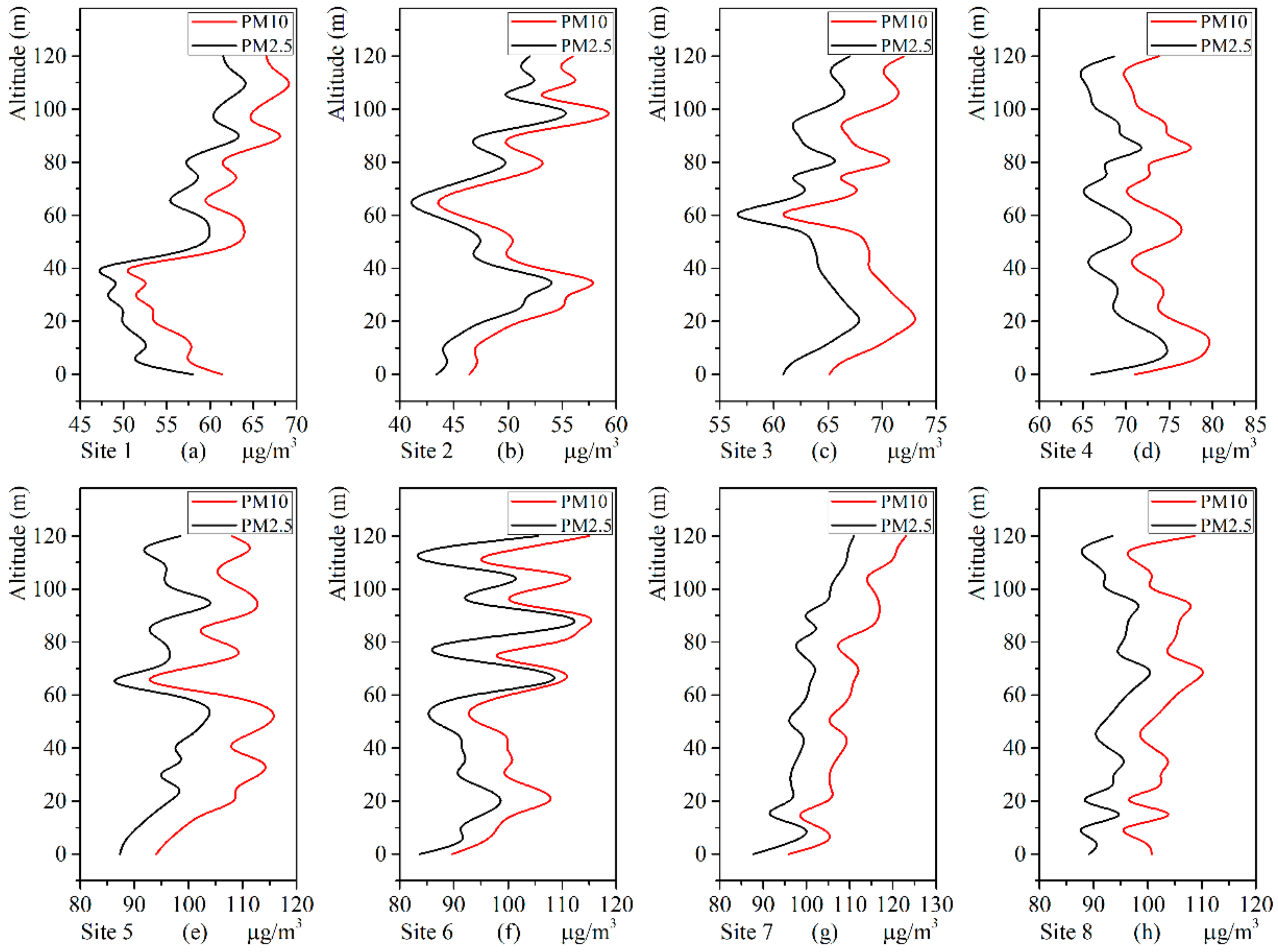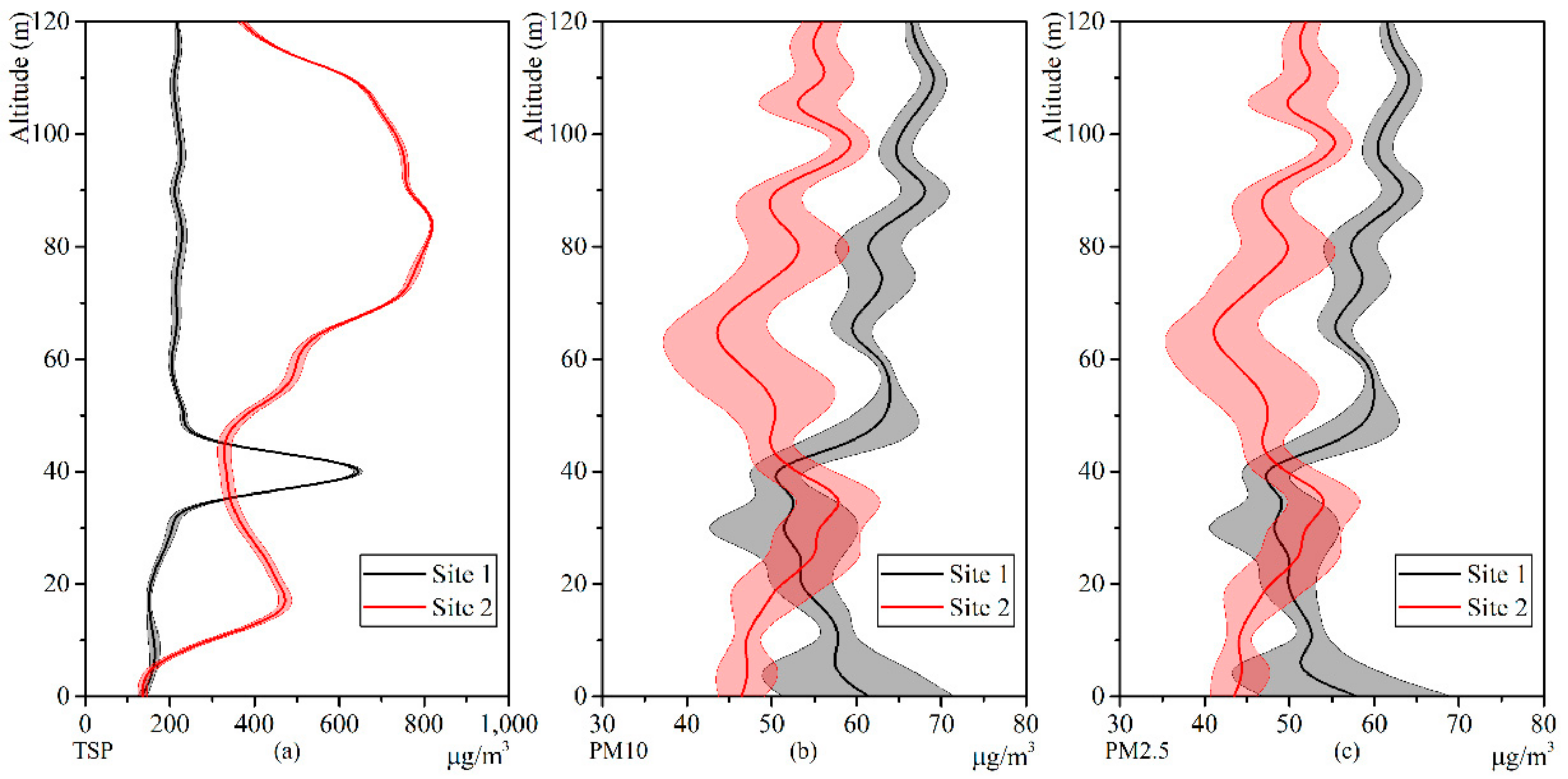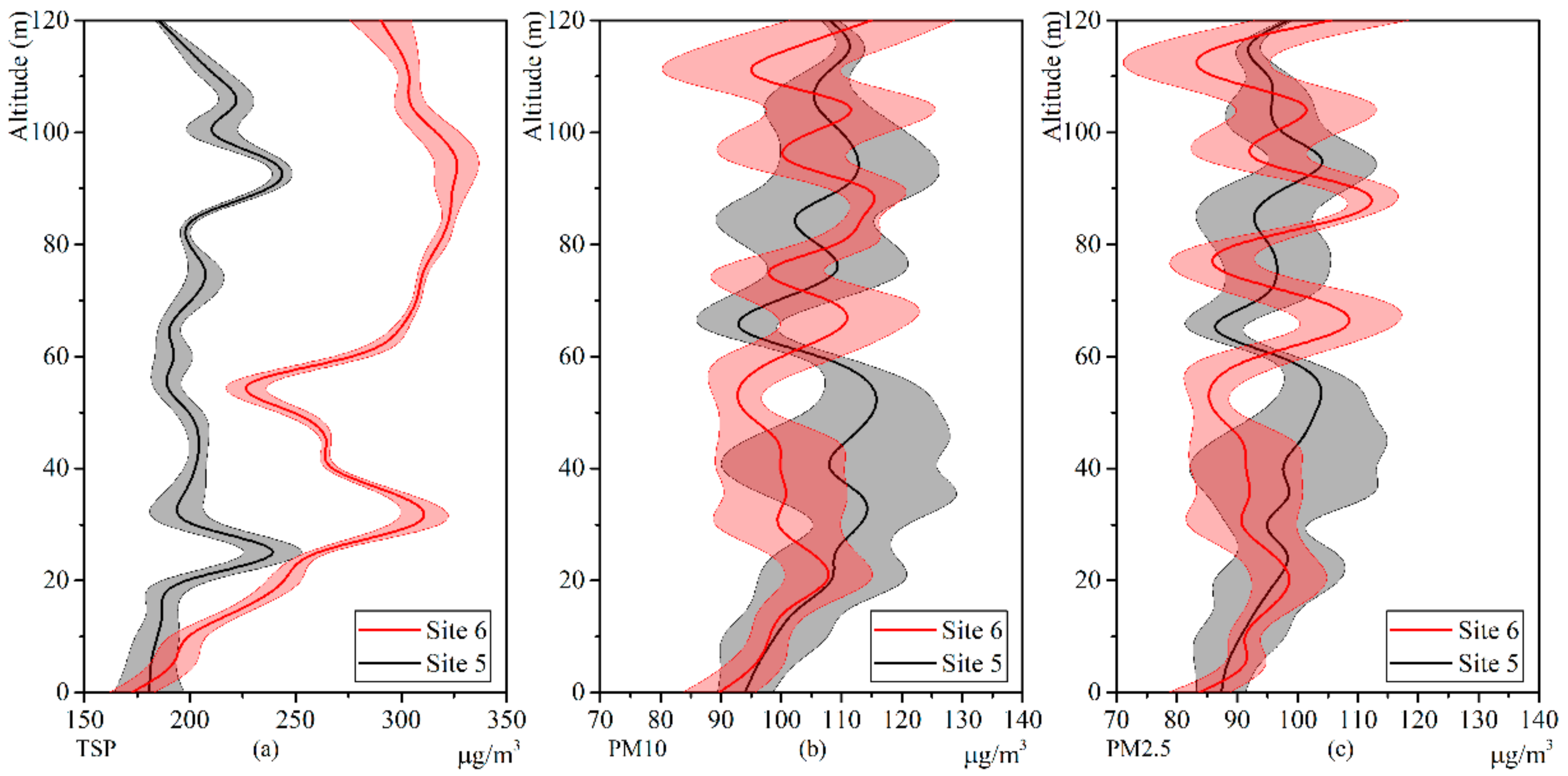Vertical Distribution of Particulates within the Near-Surface Layer of Dry Bulk Port and Influence Mechanism: A Case Study in China
Abstract
1. Introduction
2. Materials and Methods
2.1. Measurement Sites
2.2. Ambient Particulate Matter (PM) Standards
2.3. Unmanned Aerial Vehicle (UAV) Based Measurement Platform
3. Results and Discussion
3.1. Distribution of PM Concentrations
3.2. Vertical Distribution of PM Concentrations
3.3. Effect of Cargo Type on PM Concentrations
3.4. Effect of Fog Cannons on PM Concentrations
3.5. Effect of Porous Fence on PM Concentrations
4. Conclusions
Author Contributions
Funding
Acknowledgments
Conflicts of Interest
References
- Wan, C.; Zhang, D.; Yan, X.; Yang, Z. A novel model for the quantitative evaluation of green port development-A case study of major ports in China. Transp. Res. Part D Transp. Environ. 2018, 61, 431–443. [Google Scholar] [CrossRef]
- Grote, M.; Mazurek, N.; Gräbsch, C.; Zeilinger, J.; Le Floch, S.; Wahrendorf, D.; Höfer, T. Dry bulk cargo shipping-An overlooked threat to the marine environment? Mar. Pollut. Bull. 2016, 110, 511–519. [Google Scholar] [CrossRef] [PubMed]
- Van Vianen, T.; Ottjes, J.; Lodewijks, G. Simulation-based determination of the required stockyard size for dry bulk terminals. Simul. Model. Pract. Theory 2014, 42, 119–128. [Google Scholar] [CrossRef]
- Hoffmann, J.; Asariotis, R.; Assaf, M.; Benamara, H. Review of Maritime Transport; United Nations Publications: New York, NY, USA, 2018; pp. 3–80. [Google Scholar]
- Merico, E.; Dinoi, A.; Contini, D. Development of an integrated modelling-measurement system for near-real-time estimates of harbour activity impact to atmospheric pollution in coastal cities. Transp. Res. Part D Transp. Environ. 2019, 73, 108–119. [Google Scholar] [CrossRef]
- Lin, Y.; Yan, L.; Wang, Y. Performance Evaluation and Investment Analysis for Container Port Sustainable Development in China: An Inverse DEA Approach. Sustainability 2019, 11, 4617. [Google Scholar] [CrossRef]
- Santos, M.; Radicchi, E.; Zagnoli, P. Port’s Role as a Determinant of Cruise Destination Socio-Economic Sustainability. Sustainability 2019, 11, 4542. [Google Scholar] [CrossRef]
- Mueller, D.; Uibel, S.; Takemura, M.; Klingelhoefer, D.; Groneberg, D.A. Ships, ports and particulate air pollution—An analysis of recent studies. J. Occup. Med. Toxicol. 2011, 6, 31–37. [Google Scholar] [CrossRef]
- Zhao, B.; Su, Y.; He, S.; Zhong, M.; Cui, G. Evolution and comparative assessment of ambient air quality standards in China. J. Integr. Environ. Sci. 2016, 13, 85–102. [Google Scholar] [CrossRef]
- Bachmann, J. Will the Circle Be Unbroken: A History of the U.S. National Ambient Air Quality Standards. J. Air Waste Manag. 2012, 57, 652–697. [Google Scholar] [CrossRef]
- Cao, J.; Chow, J.C.; Lee, F.S.C.; Watson, J.G. Evolution of PM2.5 Measurements and Standards in the U.S. and Future Perspectives for China. Aerosol Air Qual. Res. 2013, 13, 1197–1211. [Google Scholar] [CrossRef]
- Lam, J.; Yap, W. A Stakeholder Perspective of Port City Sustainable Development. Sustainability 2019, 11, 447. [Google Scholar] [CrossRef]
- Borriello, F. The Sustainability of Mediterranean Port Areas: Environmental Management for Local Regeneration in Valencia. Sustainability 2013, 5, 4288–4311. [Google Scholar] [CrossRef]
- Cerreta, M.; De Toro, P. Strategic Environmental Assessment of Port Plans in Italy: Experiences, Approaches, Tools. Sustainability 2012, 4, 2888–2921. [Google Scholar] [CrossRef]
- Saraga, D.E.; Tolis, E.I.; Maggos, T.; Vasilakos, C.; Bartzis, J.G. PM2.5 source apportionment for the port city of Thessaloniki, Greece. Sci. Total Environ. 2019, 650, 2337–2354. [Google Scholar] [CrossRef]
- Yang, L.; Cai, Y.; Zhong, X.; Shi, Y.; Zhang, Z. A Carbon Emission Evaluation for an Integrated Logistics System—A Case Study of the Port of Shenzhen. Sustainability 2017, 9, 462. [Google Scholar] [CrossRef]
- Bermúdez, F.M.; Laxe, F.G.; Aguayo-Lorenzo, E. Assessment of the tools to monitor air pollution in the Spanish ports system. Air Qual. Atmos. Health 2019, 12, 651–659. [Google Scholar] [CrossRef]
- Bjerkan, K.Y.; Seter, H. Reviewing tools and technologies for sustainable ports: Does research enable decision making in ports? Transp. Res. Part D Transp. Environ. 2019, 72, 243–260. [Google Scholar] [CrossRef]
- Woo, J.; Moon, D.S.H.; Lam, J.S.L. The impact of environmental policy on ports and the associated economic opportunities. Transp. Res. Pt. A Policy Pract. 2018, 110, 234–242. [Google Scholar]
- Perez, N.; Pey, J.; Reche, C.; Cortes, J.; Alastuey, A.; Querol, X. Impact of harbour emissions on ambient PM10 and PM2.5 in Barcelona (Spain): Evidences of secondary aerosol formation within the urban area. Sci. Total Environ. 2016, 571, 237–250. [Google Scholar] [CrossRef]
- Jeong, J.; Shon, Z.; Kang, M.; Song, S.; Kim, Y.; Park, J.; Kim, H. Comparison of source apportionment of PM 2.5 using receptor models in the main hub port city of East Asia: Busan. Atmos. Environ. 2017, 148, 115–127. [Google Scholar] [CrossRef]
- Mousavi, A.; Sowlat, M.H.; Hasheminassab, S.; Polidori, A.; Shafer, M.M.; Schauer, J.J.; Sioutas, C. Impact of emissions from the Ports of Los Angeles and Long Beach on the oxidative potential of ambient PM 0.25 measured across the Los Angeles County. Sci. Total Environ. 2019, 651, 638–647. [Google Scholar] [CrossRef] [PubMed]
- Zhang, J.; Ji, Y.; Zhao, J.; Zhao, J. Optimal location of a particulate matter sampling head outside an unmanned aerial vehicle. Particuology 2017, 32, 153–159. [Google Scholar] [CrossRef]
- Peng, Z.; Wang, D.; Wang, Z.; Gao, Y.; Lu, S. A study of vertical distribution patterns of PM 2.5 concentrations based on ambient monitoring with unmanned aerial vehicles: A case in Hangzhou. China Atmos. Environ. 2015, 123, 357–369. [Google Scholar] [CrossRef]
- Li, X.; Wang, D.; Lu, Q.; Peng, Z.; Wang, Z. Investigating vertical distribution patterns of lower tropospheric PM2.5 using unmanned aerial vehicle measurements. Atmos. Environ. 2018, 173, 62–71. [Google Scholar] [CrossRef]
- Alvarado, M.; Gonzalez, F.; Erskine, P.; Cliff, D.; Heuff, D. A methodology to monitor airborne PM10 dust particles using a small unmanned aerial vehicle. Sensors 2017, 17, 343. [Google Scholar] [CrossRef]
- Watts, A.C.; Ambrosia, V.G.; Hinkley, E.A. Unmanned Aircraft Systems in Remote Sensing and Scientific Research: Classification and Considerations of Use. Remote Sens. 2012, 4, 1671–1692. [Google Scholar] [CrossRef]
- Elston, J.; Argrow, B.; Stachura, M.; Weibel, D.; Lawrence, D.; Pope, D. Overview of small fixed-wing unmanned aircraft for meteorological sampling. J. Atmos. Ocean. Tech. 2015, 32, 97–115. [Google Scholar] [CrossRef]
- Villa, T.F.; Gonzalez, F.; Miljievic, B.; Ristovski, Z.D.; Morawska, L. An overview of small unmanned aerial vehicles for air quality measurements: Present applications and future prospectives. Sensors 2016, 16, 1072. [Google Scholar] [CrossRef]
- Villa, T.F.; Salimi, F.; Morton, K.; Morawska, L.; Gonzalez, F. Development and validation of a UAV based system for air pollution measurements. Sensors 2016, 16, 2202. [Google Scholar] [CrossRef]
- Kuuluvainen, H.; Poikkimaki, M.; Jarvinen, A.; Kuula, J.; Irjala, M.; Dal Maso, M.; Keskinen, J.; Timonen, H.; Niemi, J.V.; Ronkko, T. Vertical profiles of lung deposited surface area concentration of particulate matter measured with a drone in a street canyon. Environ. Pollut. 2018, 241, 96–105. [Google Scholar] [CrossRef]
- Sheng, Q.; Zhang, Y.; Zhu, Z.; Li, W.; Xu, J.; Tang, R. An experimental study to quantify road greenbelts and their association with PM2.5 concentration along city main roads in Nanjing, China. Sci. Total Environ. 2019, 667, 710–717. [Google Scholar] [CrossRef] [PubMed]
- Aurell, J.; Mitchell, W.; Chirayath, V.; Jonsson, J.; Tabor, D.; Gullett, B. Field determination of multipollutant, open area combustion source emission factors with a hexacopter unmanned aerial vehicle. Atmos. Environ. 2017, 166, 433–440. [Google Scholar] [CrossRef] [PubMed]
- Yang, S.; Chen, B.; Fath, B. Trans-boundary total suspended particulate matter (TSPM) in urban ecosystems. Ecol. Model. 2015, 318, 59–63. [Google Scholar] [CrossRef]
- Grami, A. Probability, Random Variables, Statistics, and Random Processes, 1st ed.; John Wiley & Sons, Inc.: Hoboken, NJ, USA, 2019; pp. 241–257. [Google Scholar]
- Almeida, S.M.; Silva, A.V.; Freitas, M.C.; Marques, A.M.; Ramos, C.A.; Silva, A.I.; Pinheiro, T. Characterization of dust material emitted during harbour activities by k0-INAA and PIXE. J. Radioanal. Nucl. 2012, 291, 77–82. [Google Scholar] [CrossRef]
- Li, Y.; Chen, Q.; Zhao, H.; Wang, L.; Tao, R. Variations in PM 10, PM 2.5 and PM 1.0 in an urban area of the sichuan basin and their relation to meteorological factors. Atmosphere 2015, 6, 150–163. [Google Scholar] [CrossRef]
- Cong, X.C.; Du, H.B.; Peng, S.T.; Dai, M.X. Field measurements of shelter efficacy for installed wind fences in the open coal yard. J. Wind Eng. Ind. Aerod. 2013, 117, 18–24. [Google Scholar] [CrossRef]
- Johnson, K.K.; Bergin, M.H.; Russell, A.G.; Hagler, G.S.W. Field test of several low-cost particulate matter sensors in high and low concentration urban environments. Aerosol Air Qual. Res. 2018, 18, 56–578. [Google Scholar] [CrossRef]
- Sajjadi, S.A.; Zolfaghari, G.; Adab, H.; Allahabadi, A.; Delsouz, M. Measurement and modeling of particulate matter concentrations: Applying spatial analysis and regression techniques to assess air quality. MethodsX 2017, 4, 372–390. [Google Scholar] [CrossRef]
- Gozzi, F.; Della Ventura, G.; Marcelli, A. Mobile monitoring of particulate matter: State of art and perspectives. Atmos. Pollut. Res. 2016, 7, 228–234. [Google Scholar] [CrossRef]
- Alastuey, A.; Moreno, N.; Querol, X.; Viana, M.; Artíñano, B.; Luaces, J.A.; Basora, J.; Guerra, A. Contribution of harbour activities to levels of particulate matter in a harbour area: Hada Project-Tarragona Spain. Atmos. Environ. 2007, 41, 6366–6378. [Google Scholar] [CrossRef]
- Sorte, S.; Arunachalam, S.; Naess, B.; Seppanen, C.; Rodrigues, V.; Valencia, A.; Borrego, C.; Monteiro, A. Assessment of source contribution to air quality in an urban area close to a harbor: Case-study in Porto, Portugal. Sci. Total Environ. 2019, 662, 347–360. [Google Scholar] [CrossRef] [PubMed]
- Olszowski, T.; Ziembik, Z. An alternative conception of PM 10 concentration changes after short-term precipitation in urban environment. J. Aerosol Sci. 2018, 121, 21–30. [Google Scholar] [CrossRef]
- Štrbová, K.; Raclavská, H.; Bílek, J. Impact of fugitive sources and meteorological parameters on vertical distribution of particulate matter over the industrial agglomeration. J. Environ. Manag. 2017, 203, 1190–1198. [Google Scholar] [CrossRef] [PubMed]
- Zhou, Q.; Qin, B.; Wang, J.; Wang, H.; Wang, F. Experimental investigation on the changes of the wettability and surface characteristics of coal dust with different fractal dimensions. Colloids Surf. A Physicochem. Eng. Asp. 2018, 551, 148–157. [Google Scholar] [CrossRef]
- Peng, H.; Nie, W.; Yu, H.; Cheng, W.; Bai, P.; Liu, Q.; Liu, Z.; Yang, S.; Xu, C.; Hua, Y.; et al. Research on mine dust suppression by spraying: Development of an air-assisted PM10 control device based on CFD technology. Adv. Powder Technol. 2019, 30, 2588–2599. [Google Scholar] [CrossRef]
- Cong, X.C.; Cao, S.Q.; Chen, Z.L.; Peng, S.T.; Yang, S.L. Impact of the installation scenario of porous fences on wind-blown particle emission in open coal yards. Atmos. Environ. 2011, 45, 5247–5253. [Google Scholar] [CrossRef]
- Hong, S.; Lee, I.; Seo, I. Modelling and predicting wind velocity patterns for windbreak fence design. J. Wind Eng. Ind. Aerod. 2015, 142, 53–64. [Google Scholar] [CrossRef]
- Kim, R.; Lee, I.; Kwon, K.; Yeo, U.; Lee, S.; Lee, M. Design of a windbreak fence to reduce fugitive dust in open areas. Comput. Electron. Agric. 2018, 149, 150–165. [Google Scholar] [CrossRef]










| Indicator | Averaging Period | China (µg/m3) | US (µg/m3) | California (µg/m3) | EU (µg/m3) | WHO (µg/m3) | |
|---|---|---|---|---|---|---|---|
| Grade-1 | Grade-2 | ||||||
| TSP | 24-hr | 120 | 300 | None | None | None | None |
| Annual | 80 | 200 | None | None | None | None | |
| PM10 | 24-hr | 50 | 150 | None | 50 | 50 | 50 |
| Annual | 40 | 70 | 150 | 20 | 40 | 20 | |
| PM2.5 | 24-hr | 35 | 75 | 35 | None | None | 25 |
| Annual | 15 | 35 | 12 | 12 | 25 | 10 | |
| PM Type | Site 1 | Site 2 | Site 3 | Site 4 | Site5 | Site 6 | Site 7 | Site 8 |
|---|---|---|---|---|---|---|---|---|
| TSP | 0.17 | 0.49 | 0.19 | 0.07 | 0.10 | 0.19 | 0.23 | 0.10 |
| PM10 | 0.13 | 0.11 | 0.08 | 0.05 | 0.09 | 0.14 | 0.10 | 0.10 |
| PM2.5 | 0.13 | 0.11 | 0.08 | 0.05 | 0.08 | 0.13 | 0.09 | 0.09 |
| Site1 | Site2 | Site3 | |||||||
| TSP | PM10 | PM2.5 | TSP | PM10 | PM2.5 | TSP | PM10 | PM2.5 | |
| TSP | 1.00 | 0.25 | 0.26 | 1.00 | 0.24 | 0.23 | 1.00 | 0.37 | 0.35 |
| PM10 | 1.00 | 0.99 | 1.00 | 0.99 | 1.00 | 0.99 | |||
| PM2.5 | 1.000 | 1.00 | 1.00 | ||||||
| Site4 | Site5 | Site6 | |||||||
| TSP | PM10 | PM2.5 | TSP | PM10 | PM2.5 | TSP | PM10 | PM2.5 | |
| TSP | 1.00 | 0.06 | 0.12 | 1.00 | 0.31 | 0.32 | 1.00 | 0.44 | 0.44 |
| PM10 | 1.00 | 0.99 | 1.00 | 0.99 | 1.00 | 0.99 | |||
| PM2.5 | 1.00 | 1.000 | 1.00 | ||||||
| Site7 | Site8 | ||||||||
| TSP | PM10 | PM2.5 | TSP | PM10 | PM2.5 | ||||
| TSP | 1.00 | 0.03 | 0.03 | 1.00 | 0.31 | 0.32 | |||
| PM10 | 1.00 | 0.99 | 1.00 | 0.99 | |||||
| PM2.5 | 1.00 | 1.00 | |||||||
© 2019 by the authors. Licensee MDPI, Basel, Switzerland. This article is an open access article distributed under the terms and conditions of the Creative Commons Attribution (CC BY) license (http://creativecommons.org/licenses/by/4.0/).
Share and Cite
Shen, J.; Feng, X.; Zhuang, K.; Lin, T.; Zhang, Y.; Wang, P. Vertical Distribution of Particulates within the Near-Surface Layer of Dry Bulk Port and Influence Mechanism: A Case Study in China. Sustainability 2019, 11, 7135. https://doi.org/10.3390/su11247135
Shen J, Feng X, Zhuang K, Lin T, Zhang Y, Wang P. Vertical Distribution of Particulates within the Near-Surface Layer of Dry Bulk Port and Influence Mechanism: A Case Study in China. Sustainability. 2019; 11(24):7135. https://doi.org/10.3390/su11247135
Chicago/Turabian StyleShen, Jinxing, Xuejun Feng, Kai Zhuang, Tong Lin, Yan Zhang, and Peifang Wang. 2019. "Vertical Distribution of Particulates within the Near-Surface Layer of Dry Bulk Port and Influence Mechanism: A Case Study in China" Sustainability 11, no. 24: 7135. https://doi.org/10.3390/su11247135
APA StyleShen, J., Feng, X., Zhuang, K., Lin, T., Zhang, Y., & Wang, P. (2019). Vertical Distribution of Particulates within the Near-Surface Layer of Dry Bulk Port and Influence Mechanism: A Case Study in China. Sustainability, 11(24), 7135. https://doi.org/10.3390/su11247135




